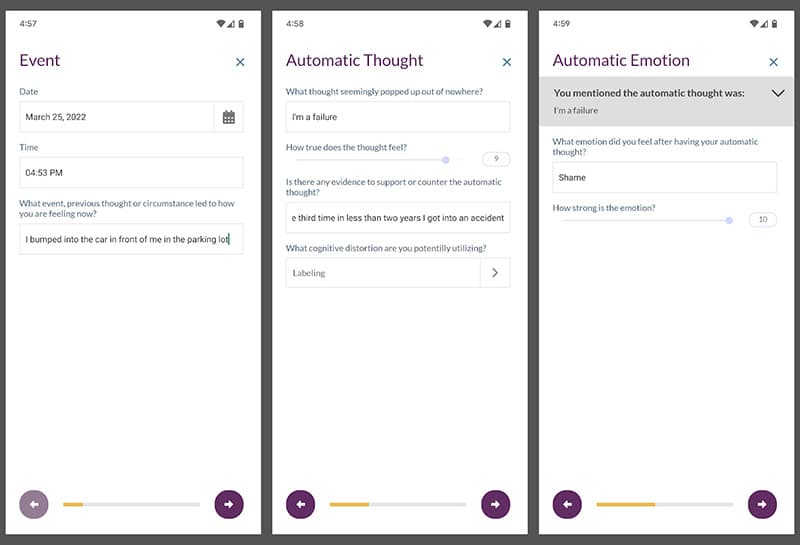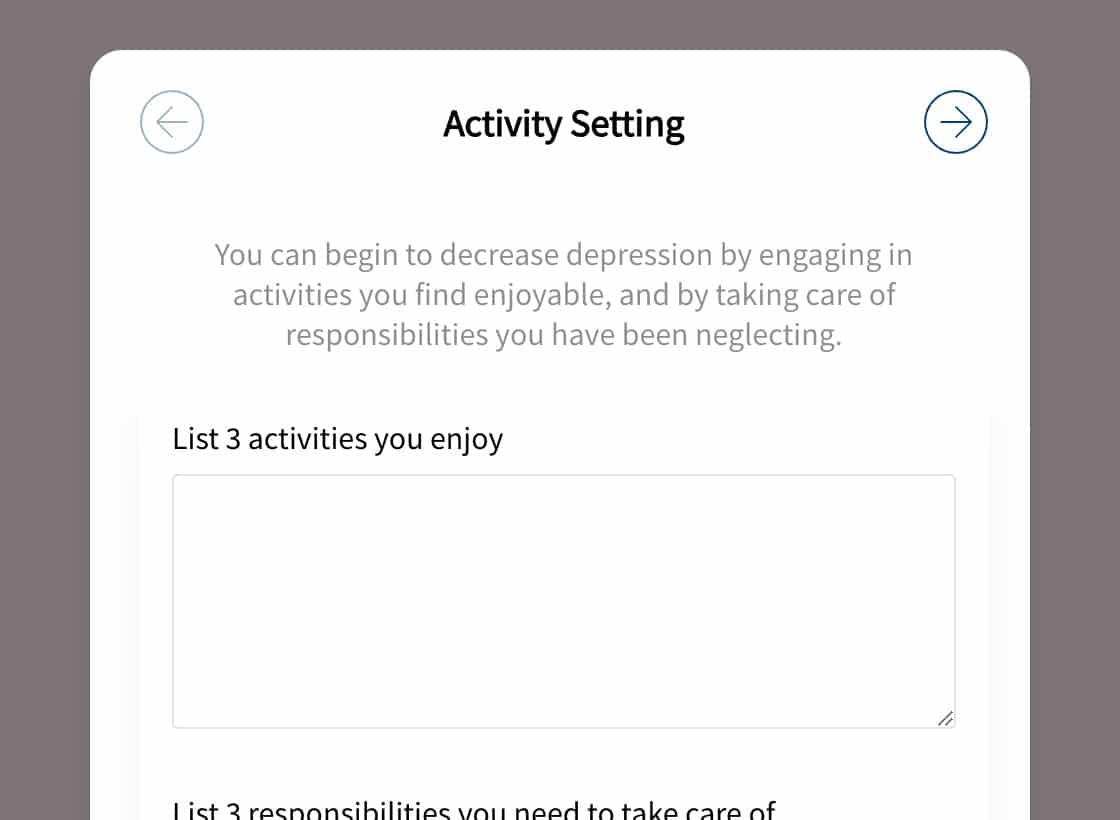Free Download: Thought Record Worksheet
Template by Reflective
Best for CBT
Use a thought record worksheet, also called a thought diary or thought journal, with patients to help them identify and challenge negative thought patterns, ultimately promoting healthier emotional responses and better coping strategies.
Thought Record in the Reflective app is so much better than a PDF Worksheet
Download the printable PDF worksheet, or share the thought record worksheet with your patient with the Reflective app. Simply enter their email, and they’ll be able to fill in the thought record from the convenience of their phone. Get started for free!
How does Reflective work?
Share exercise with client via Reflective
Client receives email with app link and connection request
Client clicks link to download app
Client accepts your connection and exercises you shared
Client uses app to fill in exercises, gets reminders
What is a Thought Record?
A thought record is a practical tool used in cognitive-behavioral therapy (CBT) to help individuals identify and change negative thought patterns. It serves as a structured worksheet where patients document their thoughts, emotions, and situations that lead to distress. By breaking down these experiences, patients can better understand how their thoughts influence their feelings and behaviors.
The thought record typically includes several sections: the situation that triggered the emotion, the automatic thoughts that arose, the emotions felt, and the intensity of those emotions. Patients also provide evidence for and against their automatic thoughts, which helps them evaluate these thoughts more objectively. Finally, they are encouraged to develop a more balanced and realistic perspective to replace the negative thought.
Using a thought record helps patients gain insight into their cognitive processes. By regularly documenting their experiences, they learn to recognize patterns in their thinking and identify cognitive distortions. This awareness is the first step toward changing unhelpful thought patterns, leading to healthier emotional responses and improved coping strategies.
For therapists, thought records offer a window into the patient’s internal world, revealing how they interpret and react to different situations. This information can guide more effective interventions and treatment plans. Thought records also empower patients to take an active role in their therapy, providing them with a concrete method to practice cognitive restructuring outside of sessions. This can enhance the therapeutic process and support long-term mental health improvement.
History of Thought Records
Thought records are a core component of cognitive behavioral therapy (CBT), a therapeutic approach developed by Dr. Aaron T. Beck in the 1960s. Dr. Beck, originally trained in psychoanalysis, became interested in the cognitive processes underlying depression. Through his research, he discovered that patients with depression often experienced automatic negative thoughts that contributed to their emotional distress. He termed these thoughts “cognitive distortions” and recognized that addressing them could significantly alleviate depressive symptoms.
In developing CBT, Dr. Beck introduced the thought record as a practical tool to help patients systematically identify, evaluate, and modify these negative thoughts. The thought record provided a structured way for patients to document their thoughts, emotions, and situations, facilitating a deeper understanding of how their thinking patterns affected their mood and behavior. This approach marked a significant shift from traditional psychoanalytic methods, emphasizing a more active and collaborative role for patients in their own treatment.
Over the years, thought records have been refined and adapted for various mental health issues beyond depression, including anxiety, post-traumatic stress disorder (PTSD), and eating disorders. The basic format has remained consistent, focusing on helping patients recognize and challenge cognitive distortions. Thought records have been incorporated into numerous CBT manuals and training programs, becoming a staple technique for therapists worldwide.
The efficacy of thought records has been supported by extensive research, demonstrating their effectiveness in reducing symptoms of depression and anxiety. By providing a structured method for cognitive restructuring, thought records empower patients to develop healthier thinking patterns and improve their emotional well-being. Today, they are widely used in both individual and group therapy settings, reflecting their enduring value in the field of cognitive-behavioral therapy.
How to use this worksheet
Thought records are a straightforward, evidence-based tool that not only enhances your patients’ self-awareness but also actively empowers them to transform their negative thought patterns into healthier, more balanced perspectives. Discover how incorporating thought records into your practice can lead to more engaged, proactive patients and more effective therapeutic outcomes.
Step 1: Select a Thought Record from the template library
Therapists can select two versions of thought record to add to the patient’s workbook. Reflective offers a full thought record with all the sections and fields in a classical thought record. There is also a second, lighter version, of thought record which is useful to start your patients out on the idea, with fewer fields to fill out to help them get acquainted.
We will focus on the full Thought Record version.
Step 2: Share with your patient
Use the button above to share with your patient. Simply enter their email address and your basic information so they know this is coming from you, and they will get a link to the worksheet.
Step 3: Familiarize yourself with the Thought Record
The thought record is broken out into sections: the Event, the Automatic Thought, the Automatic Emotion, the Resulting Behavior, Working Thought, Working Emotion, and the Intended Behavior.
The Event
The patient should describe the event in factual terms: what happened? They should log the time and date, as well.
The Automatic Thought
The patient should describe the immediate thought that popped into their head. They should log how true that thought felt, on a scale of 1 to 10, 10 being “Absolutely True.” They should list any evidence to support or counter that automatic thought. Lastly, the patient should select the thought distortion they are potentially utilizing with that thought.
In Reflective, the “Thought Distortion” selector includes explanations and examples of each thought distortion.
The Automatic Emotion
In this section the patient should write how they felt after the automatic thought, and rate on a numeric scale how strong that feeling was.
Resulting Behavior
The thought and feeling influenced their behavior. Now the patient should describe the resulting behavior they engaged in.
Optionally, the patient can also describe physical sensations or additional automatic thoughts associated with that behavior. They can also optionally list any pros and cons of those behaviors.
Those optional fields are particularly helpful in working with OCD patients, such as those struggling with dermatillomania (skin picking, or excoriation disorder) or trichotillomania (hair-pulling disorder).
Working Thought and Working Emotion
Next, the patient should describe a more appropriate thought and the resulting emotion. After analyzing the situation and examining the evidence, what would be a more appropriate thought? How do they feel after working through the thought?
For each, they can rate on a numerical scale how much they believe the new thought and how strong the feeling was.
Intended Behavior
Finally, the patient should describe the behavior they intend to engage in, and if there are any physical sensations or additional automatic thoughts that present.
Step 4: Repeat as needed
You can set the thought record to filled in as frequently as you feel is appropriate for your patient, and the patient can set up reminders on their schedule. They can fill in the thought record as much as they need to.
Thought Record PDF Worksheet
To get a better understanding of how thought records can be effectively utilized in your practice, we download a sample Thought Record Worksheet PDF. This resource provides a clear template that demonstrates how to document situations, emotions, automatic thoughts, evidence for and against these thoughts, and more balanced perspectives. By reviewing this sample, you can see how thought records are structured and how they guide patients in recognizing and challenging their cognitive distortions. This practical example will serve as a useful reference, whether you plan to introduce thought records in your sessions or encourage patients to complete them between visits.
The Benefits of using Thought Records or Thought Diary Worksheets
Thought records are a valuable tool in cognitive-behavioral therapy (CBT), providing numerous benefits for both therapists and patients. This worksheet not only helps patients identify and challenge negative thought patterns but also empowers them to develop healthier cognitive habits. Here’s how thought records can make a significant difference in managing various mental health conditions.
Building Awareness of Thought Distortions
One of the primary benefits of using thought records is that they help patients become more aware of their cognitive distortions. By documenting their thoughts, emotions, and the situations that trigger them, patients can clearly see patterns in their thinking. This heightened awareness allows them to recognize when their thoughts are irrational or overly negative, providing a crucial first step towards cognitive restructuring. Over time, patients learn to question and modify these distortions, leading to more balanced and realistic thinking.
Understanding the Impact of Thoughts on Behaviors
Thought records also elucidate the powerful connection between thoughts and behaviors. By examining how specific thoughts lead to certain emotions and actions, patients gain insight into their behavioral responses. This understanding can be particularly enlightening for those who feel trapped in automatic, maladaptive patterns. Through this process, patients can begin to see how changing their thoughts can lead to different, more positive behaviors and emotional states.
Addressing OCD
For patients with obsessive-compulsive disorder (OCD), thought records are instrumental in breaking the cycle of obsessive thoughts and compulsive behaviors. By documenting their obsessive thoughts and evaluating the evidence for and against them, patients can start to challenge the validity of these thoughts. This practice helps reduce the anxiety associated with obsessions and can decrease the compulsion to engage in repetitive behaviors, ultimately providing relief from OCD symptoms.
Managing Depression
In the context of depression, thought records help patients identify and combat the negative thought patterns that perpetuate their depressive symptoms. Depressed individuals often experience pervasive negative thinking about themselves, the world, and the future. By using thought records to systematically challenge these thoughts, patients can develop a more positive and hopeful outlook, which is essential for recovery.
Reducing Anxiety
Anxiety disorders are characterized by excessive worry and catastrophic thinking. Thought records allow patients to track their anxious thoughts and examine the evidence supporting these fears. This practice can reveal that many of their worries are unfounded or exaggerated. As patients learn to dispute their anxious thoughts, they often experience a significant reduction in anxiety, leading to a calmer and more balanced state of mind.
Treating PTSD
Patients with post-traumatic stress disorder (PTSD) frequently struggle with intrusive thoughts and memories related to their trauma. Thought records can help these individuals process their traumatic experiences by identifying and challenging the distorted thoughts that trigger their distress. By reframing these thoughts, patients can reduce the emotional intensity of their memories and develop healthier coping mechanisms, aiding in their overall recovery from PTSD.
Why all therapists should use Reflective in their practice
Incorporating Reflective into your mental health practice can revolutionize the therapeutic experience for both you and your patients. Reflective is designed to improve patient outcomes and, in turn, enhance therapist income by reducing patient churn. It keeps patients therapeutically engaged between sessions, ensuring they remain focused on their goals and committed to their treatment plans. The increased accountability provided by Reflective, alongside timely notifications and reminders, helps patients stay compliant and motivated.
Reflective seamlessly integrates with patients’ health records, offering therapists enhanced insight and visibility into their patients’ progress. This integration allows you to tailor interventions more precisely and track improvements effectively. Patients appreciate the added support Reflective provides, as well as the easy access to content, files, and exercises that enrich their therapy experience.
By using Reflective, you can ensure that your patients feel continuously supported, which fosters a stronger therapeutic alliance and enhances overall treatment efficacy.



